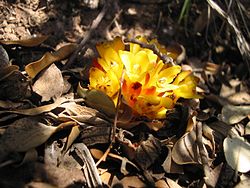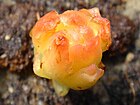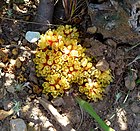Note: This is a project under development. The articles on this wiki are just being initiated and broadly incomplete. You can Help creating new pages.
Difference between revisions of "Cytinus hypocistis"
(→Photo Gallery) |
|||
| (10 intermediate revisions by 2 users not shown) | |||
| Line 1: | Line 1: | ||
[[File:Cytinus.ruber.jpg|thumb|right|''Cytinus'']] | [[File:Cytinus.ruber.jpg|thumb|right|''Cytinus'']] | ||
| − | + | '''Cytinus hypocistis''' is a genus of parasitic [[Flowering plant]]s. Species in this genus do not produce chlorophyll but rely fully on its host plant. It has also been found on Ptilostemon chamaepeuce. | |
| − | '''Cytinus''' is a genus of parasitic [[Flowering plant]]s. Species in this genus do not produce chlorophyll | ||
| − | |||
==Uses== | ==Uses== | ||
{{Uses|Wounds}}, {{Uses|Cuts}}, {{Uses|Snakebites}}, {{Uses|Curing liver disorders}}, {{Uses|Skin eruptions}}, {{Uses|Blotches}}, {{Uses|Pimples}}, {{Uses|Diarrhea}}, {{Uses|Sore throats}}<ref name="Uses"/> | {{Uses|Wounds}}, {{Uses|Cuts}}, {{Uses|Snakebites}}, {{Uses|Curing liver disorders}}, {{Uses|Skin eruptions}}, {{Uses|Blotches}}, {{Uses|Pimples}}, {{Uses|Diarrhea}}, {{Uses|Sore throats}}<ref name="Uses"/> | ||
==Parts Used== | ==Parts Used== | ||
| − | {{Parts Used|Dried | + | {{Parts Used|Dried folaige}}, {{Parts Used|Whole herb}}. |
==Chemical Composition== | ==Chemical Composition== | ||
| Line 26: | Line 24: | ||
===Fruit=== | ===Fruit=== | ||
| − | {{Fruit||7–10 mm (0.28–0.4 in.) long pome| | + | {{Fruit||7–10 mm (0.28–0.4 in.) long pome|Clearly grooved lengthwise, Lowest hooked hairs aligned towards crown|With hooked hairs|}} |
===Other features=== | ===Other features=== | ||
==List of Ayurvedic medicine in which the herb is used== | ==List of Ayurvedic medicine in which the herb is used== | ||
| − | |||
==Where to get the saplings== | ==Where to get the saplings== | ||
| Line 38: | Line 35: | ||
==How to plant/cultivate== | ==How to plant/cultivate== | ||
| − | |||
==Commonly seen growing in areas== | ==Commonly seen growing in areas== | ||
| − | |||
==Photo Gallery== | ==Photo Gallery== | ||
<gallery class="left" caption="" widths="140px" heights="140px"> | <gallery class="left" caption="" widths="140px" heights="140px"> | ||
File:Cytinus hypocistis.jpg | File:Cytinus hypocistis.jpg | ||
| − | + | File:Cytinus hypocistis 1.jpg | |
| − | + | File:Cytinus hypocistis-.jpg | |
| − | + | File:Cytinus hypocistis . - CYTINACEAE - Flickr - gailhampshire.jpg | |
</gallery> | </gallery> | ||
==References== | ==References== | ||
| − | |||
<references> | <references> | ||
| − | <ref name="chemical composition">[https://www.sciencedirect.com/science/article/pii/S0378874112006393?via%3Dihub | + | <ref name="chemical composition">[https://www.sciencedirect.com/science/article/pii/S0378874112006393?via%3Dihub Sciencedirect]</ref> |
| − | + | <ref name="Leaf">[https://web.archive.org/web/20131226161459/http://www.wildflowers-guide.com/39-agrimony.html Wayback machine]</ref> | |
| − | <ref name="Leaf">[https://web.archive.org/web/20131226161459/http://www.wildflowers-guide.com/39-agrimony.html | + | <ref name="Uses">[http://www.homeremediess.com/agrimonia-eupatoria-medicinal-uses-and-images/ Traditional medicine]</ref> |
| − | |||
| − | <ref name="Uses">[http://www.homeremediess.com/agrimonia-eupatoria-medicinal-uses-and-images/ | ||
| − | |||
| − | |||
</references> | </references> | ||
==External Links== | ==External Links== | ||
| + | * [https://www.first-nature.com/flowers/cytinus-hypocistis.php Cytinus hypocistis on first-nature.com] | ||
| + | * [https://www.ncbi.nlm.nih.gov/pmc/articles/PMC4603636/ Cytinus hypocistis on ncbi.nlm.nih.gov] | ||
[[Category:Herbs]] | [[Category:Herbs]] | ||
| + | [[Category:Cytinaceae]] | ||
Latest revision as of 09:32, 23 April 2020
Cytinus hypocistis is a genus of parasitic Flowering plants. Species in this genus do not produce chlorophyll but rely fully on its host plant. It has also been found on Ptilostemon chamaepeuce.
Contents
[hide]Uses
Wounds, Cuts, Snakebites, Curing liver disorders, Skin eruptions, Blotches, Pimples, Diarrhea, Sore throats[1]
Parts Used
Chemical Composition
Contains volatile oils, flavonoids, apigenin, luteolin, quercetin, kaempferol, tiliroside, triterpene glycosides including euscapic acid and tormentic acid, phenolic acids, and 3%–21% tannins.[2]
Common names
| Language | Common name |
|---|---|
| Kannada | |
| Hindi | |
| Malayalam | |
| Tamil | |
| Telugu | |
| Marathi | NA |
| Gujarathi | NA |
| Punjabi | NA |
| Kashmiri | NA |
| Sanskrit | |
| English | Cytinus |
Habit
Identification
Leaf
| Kind | Shape | Feature |
|---|---|---|
| Simple | The leaves are divided into 3-6 toothed leaflets, with smaller leaflets in between |
Flower
| Type | Size | Color and composition | Stamen | More information |
|---|---|---|---|---|
| Unisexual | 2-4cm long | Yellow | 5-20 | Flowers Season is June - August |
Fruit
| Type | Size | Mass | Appearance | Seeds | More information |
|---|---|---|---|---|---|
| 7–10 mm (0.28–0.4 in.) long pome | Clearly grooved lengthwise, Lowest hooked hairs aligned towards crown | With hooked hairs | {{{6}}} |
Other features
List of Ayurvedic medicine in which the herb is used
Where to get the saplings
Mode of Propagation
How to plant/cultivate
Commonly seen growing in areas
Photo Gallery
References
External Links
Categories:
- Ayurvedic Herbs known to be helpful to treat Wounds
- Ayurvedic Herbs known to be helpful to treat Cuts
- Ayurvedic Herbs known to be helpful to treat Snakebites
- Ayurvedic Herbs known to be helpful to treat Curing liver disorders
- Ayurvedic Herbs known to be helpful to treat Skin eruptions
- Ayurvedic Herbs known to be helpful to treat Blotches
- Ayurvedic Herbs known to be helpful to treat Pimples
- Ayurvedic Herbs known to be helpful to treat Diarrhea
- Ayurvedic Herbs known to be helpful to treat Sore throats
- Herbs with Dried folaige used in medicine
- Herbs with Whole herb used in medicine
- Herbs with common name in English
- Habit - Herb
- Index of Plants which can be propagated by Seeds
- Index of Plants which can be propagated by Cuttings
- Herbs
- Cytinaceae




